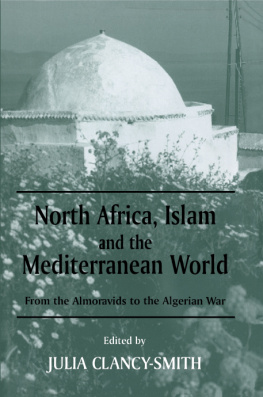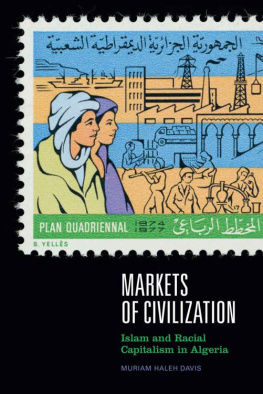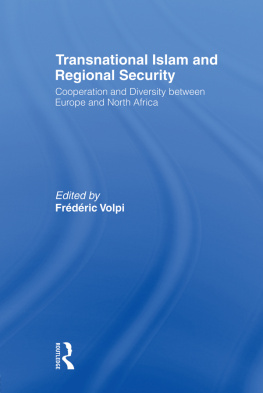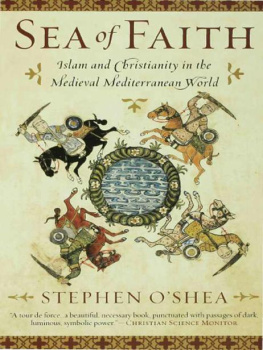North Africa, Islam and the Mediterranean World:
From the Almoravids to the Algerian War
CASS SERIES: HISTORY AND SOCIETY IN THE ISLAMIC WORLD
ISSN 1466-9390
Series Editors: Anoushiravan Ehteshami and George Joff
Contemporary events in the Islamic world dominate the headlines and emphasise the crises of the Middle East and North Africa, yet the Islamic world is far larger and more varied than we realise. Current affairs there too mask the underlying trends and values that have, over time, created a fascinating and complex world. This new series is intended to reveal that other Islamic reality by looking at its history and society over the ages. It will also reach far further, bringing in Central Asia and the Far East as part of a cultural space sharing common values and beliefs but at the same time manifesting a vast diversity of experience and social order.
- French Military Rule in Morocco: Colonialism and its Consequences
by Moshe Gershovich - Tribe and Society in Rural Morocco
by David M. Hart - The Walled Arab City in Literature, Architecture and History: The Living Medina in the Maghrib
edited by Susan Slyomovics - North Africa, Islam and the Mediterranean World: From the Almoravids to the Algerian War
edited by Julia Clancy-Smith - Technology, Tradition and Survival: Aspects of Material Culture in the Middle East and Central Asia
edited by Richard Tapper and Keith McLachlan
First published in 2001 in Great Britain by
FRANK CASS PUBLISHERS
2 Park Square, Milton Park, Abingdon, Oxon, OX14 4RN
and in the United States of America by
FRANK CASS PUBLISHERS
270 Madison Ave,
New York NY 10016
Transferred to Digital Printing 2005
Website www.frankcass.com
Copyright 2001 Frank Cass & Co. Ltd.
British Library Cataloguing in Publication Data
North Africa, Islam and the Mediterranean world: from the Almoravids to the Algerian War. (History and society in the Islamic world)
1. Africa, North History
I. Clancy- Smith, Julia A.
ISBN 0 7146 5170 2 (cloth)
ISBN 0 7146 8184 9 (paper)
ISSN 1466 9390
ISBN 978-1-135-31213-8 (epub)
Library of Congress Cataloging-in-Publication Data:
North Africa, Islam and the Mediterranean world: from the Almoravids to the Algerian War / edited by Julia Clancy-Smith.
p. cm. (History and society in the Islamic world, ISSN 1466-9390)
Includes bibliographical references and index.
ISBN 0-7146-5170-2 ISBN 0-7146-8184-9 (pbk.)
1. Africa, NorthHistory6471517. 2. Africa, NorthHistory1517-1882. 3. Africa, NorthHistory1882- .I. Clancy-Smith, Julia Ann. II. Cass serieshistory and society in the Islamic world.
DT173.N67 2001
961-dc21 2001002466
This group of studies first appeared in a Special Issue on North Africa, Islam and the Mediterranean World: From the Almoravids to the Algerian War of The Journal of North African Studies (ISSN 1362-9387) 6/1 (Spring 2001).
All rights reserved. No part of this publication may be reproduced, stored in or introduced into a retrieval system, or transmitted, in any form or by any means, electronic, mechanical, photocopying, recording or otherwise, without the prior written permission of the publisher of this book.
Printed and bound by Antony Rowe Ltd, Eastbourne
JULIA CLANCY-SMITH
Long regarded as the preserve of French scholars and audiences due to its centrality in Frances empire, North Africa is increasingly recognised for its own singular importance as a cross-roads region. Situated where Islamic, Mediterranean, Atlantic, African and European histories intersect, the Maghrib has for centuries acted as an economic conduit and cultural mediator between adjacent peoples and regions. From the medieval era, when Sijilmasa in the Moroccan wilderness funnelled gold into international networks, through the sixteenth century when two superpowers, the Ottomans and Spanish Habsburgs, battled for Mediterranean mastery along the North African frontier, and well into the twentieth century where one of Africas cruellest colonial wars unfolded in French Algeria, the Maghrib has occupied a unique place where worlds meet. Paradoxically, as Edmund Burke III pointed out, North African studies have until very recently been marginal in the academy: not quite African, not quite Arab, not quite European, the Maghrib inhabits a space between the essentialisms evoked by each.1
This special issue is the product of an international conference held in Tunisia in 1998 under the auspices of the American Institute for Maghrib Studies and the Centre dtudes Maghrbines Tunis. Specifically the conference addressed the issue of the Maghrib as a space where worlds have met throughout history, emphasising its central role in shaping those encounters. The nine essays here offer some of the latest research and thinking on North African history, especially its complex relationships with the Saharan and Mediterranean rims from the early centuries of Islam until the eve of decolonisation. One particularly useful theoretical approach for a deeper understanding of North Africas historic cross-roads role is the field of World History which provided the conceptual framework for the AIMS-CEMAT conference. A field largely unknown to Franco-phone or indigenous historians of the Maghrib, World History challenges conventional Western Civilisation paradigms which construct causation and meaning in humankinds past principally through the European tunnel of time or via the colonisers model of the world.2 And to this list should also be added the nationalists narrative of history which curiously reproduces, in many respects, the very colonial historiography it aimed to dismantle. Among the methodologies in the world history armature is comparative history as well as approaches that de-centre historical master narratives in order to transcend arbitrarily bounded units of analysis, such as nation-states and civilisations, or oppositional, mutually exclusive binaries. Frontiers, borderlands and boundaries, therefore, are the favoured haunts of many world historians for these fluid historical and cultural march lands often generate powerful intellectual displacements. Thus, thematically these articles share a common concern with the hidden histories found along various kinds of frontiers as well as the decentrings produced by a comparative historical methodology.
We begin with Amira K. Bennisons panoptic study of the shifting Iberian-Moroccan frontiers from the twelfth to the nineteenth centuries. This represented a rich zone of continual militant clashes as well as myriad exchanges or subtle accommodations and as such resembled the Turko-Byzantine march lands during the centuries-long conquest of Anatolia. Along the Strait of Gibraltar, the constant warfare inspired by crusade and jihad created liminal states, in many senses of the term, which influenced early modern state formation in Spain and Morocco. Ironically, both sides, Christian and Muslim, began to share common cultural-religious traits as each created new sacred landscapes consonant with claims to defend the faith and orthodoxy. For example, the discovery of the bodies of holy men with emblematic significance for communal identities occurred both in Christian Spain and Marinid Morocco. Moreover, Bennison argues persuasively that sanctity, like orthodoxy, was relocated on the frontier in a diachronic sequence linked to the movement of the frontier southwards and eventually across the Straits of Gibraltar. This in turn shaped Saharan and West African histories since Muslims involved in the eighteenth- and nineteenth-century












